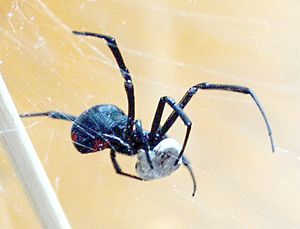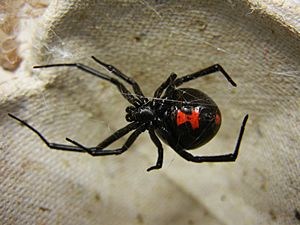Latrodectus mactans facts for kids
Quick facts for kids Latrodectus mactans |
|
|---|---|
 |
|
| Scientific classification |
The Latrodectus mactans, also known as the southern black widow or just black widow, is a type of spider that has venom. People also call it the shoe-button spider. Female black widows are famous for their shiny black bodies with a bright red hourglass shape. Sometimes, after they mate, the female might eat the male. This spider is originally from North America. Its venom is usually not deadly to healthy people.
Contents
About the Black Widow Spider
What is a Black Widow?
The southern black widow was first described in 1775. It belongs to a group of spiders called Latrodectus, which includes other black widow spiders. It is also part of the spider family called Theridiidae.
There are three main types of black widow spiders in North America:
- The southern black widow (Latrodectus mactans)
- The western black widow (Latrodectus hesperus)
- The northern black widow (Latrodectus variolus)
Before the 1970s, people thought all these spiders were the same species. Now we know they are different, but many people still call all of them "black widows." Sometimes, people confuse black widows with "false widows," which are different spiders that look a bit similar.
What Does a Black Widow Look Like?
Female black widows are about 8 to 13 millimeters long, not counting their legs. Males are smaller, about 3 to 6 millimeters long. Both have long legs compared to their bodies.
The female spider is shiny and black. She has a bright red mark shaped like an hourglass on the underside of her round belly. Her belly can get very big, especially when she is carrying eggs. Some females also have a red or orange spot on top of their belly, near where the silk comes out.
Young black widows look different. Their bodies are grayish to black with white stripes and yellow and orange spots. Male spiders are often purple or look more like the young spiders.
The web of a black widow spider is a messy, tangled net. It is made of very strong silk.
Where Do Black Widows Live?
The southern black widow mostly lives in the southeastern United States. You can find them as far north as Ohio and as far west as Texas. The northern black widow lives more in the northeastern U.S. and southeastern Canada. Their living areas can sometimes overlap.
Black widows are also found in the Dominican Republic and the Hawaiian Islands. They might have arrived in new places by traveling on things like imported fruits and vegetables.
Reproduction and Life Cycle
How Black Widows Reproduce
When a male black widow is ready to mate, he spins a special web. He puts his sperm on this web and then picks it up with special parts on his front legs called palpal bulbs. He then uses these to put the sperm into the female.
A female black widow can lay many eggs. She can make four to nine egg sacs in one summer. Each sac can hold about 100 to 400 eggs. The eggs usually hatch after 20 to 30 days.
Not many baby spiders survive. Often, fewer than 100 will hatch, and only about 30 will live past their first molting (shedding their skin). This is because some babies eat each other, or they don't have enough food or a safe place to live.
It takes about two to four months for young black widows to be old enough to mate. They usually become fully grown in six to nine months. Female black widows can live for up to three years. Males, however, only live for about three to four months. As mentioned, the female might eat the male after they mate.
What Do Black Widows Eat?
Black widow spiders mostly eat insects. They really like fire ants if they can find them. They also eat other small creatures like woodlice, millipedes, and centipedes, especially when they are young. Sometimes, they even eat other spiders.
Their strong web can sometimes catch animals as big as mice! When an animal gets stuck in the web, the black widow quickly comes out. It wraps the prey tightly in its strong silk. Then, it bites the prey and injects its venom.
The venom takes about ten minutes to work. During this time, the spider holds the prey tightly. Once the prey stops moving, the spider releases special liquids that help it digest the prey. The black widow then carries its meal back to its hiding spot to eat.
Who Are the Black Widow's Enemies?
Many animals are predators or parasites of black widow spiders in North America. However, people haven't really studied how to use these enemies to control black widow populations.
Some tiny wasps, like the Baeus latrodecti, are parasites that attack black widow egg sacs. Certain flies, like those from the Pseudogaurax group, also parasitize the egg sacs.
Adult black widows have predators too. Wasps are common enemies, especially the blue mud dauber (Chalybion californicum) and the spider wasp (Tastiotenia festiva). Other animals like mantises or centipedes might also eat black widows if they get the chance.
Scientists also found in 2012 that the brown widow spider, which is related to the black widow, might be taking over areas where black widows used to live. This means brown widows could be pushing black widows out of some places.
Black Widow Bites and Venom
Are Black Widow Bites Dangerous?
Black widow spiders have a scary reputation, and their venom does affect humans. However, only mature female black widows can bite humans and inject venom. Their fangs, called chelicerae, are about 1 millimeter long. This is long enough to inject venom into a person. The smaller male spiders cannot bite humans effectively.
The amount of venom a female injects can vary. The venom is called alpha-latrotoxin. It affects your nerves, causing symptoms. The symptoms you feel after a black widow bite are known as latrodectism.
It is extremely rare for healthy adults to die from a black widow bite. For example, between 2000 and 2008, there were over 23,000 reported black widow bites in the U.S., and none of them resulted in death.
Historically, in the 1800s and early 1900s, there were more reports of deaths from black widow bites, especially in Europe. But when antivenom (a medicine to treat venom) was created, the number of deaths dropped greatly.
In 1933, a brave scientist named Allan Blair even let a black widow bite him. He did this to study how dangerous the venom was to humans and to convince people who didn't believe the spider's venom was harmful.
The venom contains several active parts, including:
- Latrotoxins
- Smaller proteins that affect how nerves send signals
- Other chemicals like adenosine
The venom is a neurotoxin, which means it affects the nervous system.
See also
 In Spanish: Viuda negra para niños
In Spanish: Viuda negra para niños


